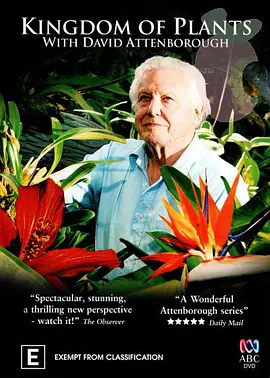植物王国
植物王国
2012年最新纪录片《植物王国》

◎译 名 植物王国
◎片 名 Kingdom of Plants
◎年 代 2012
◎国 家 英国
◎类 别 纪录
◎语 言 英语
◎字 幕 中英双字幕
◎文件格式 BD-RMVB
◎视频尺寸 1280 x 720
◎文件大小 1CD
◎片 长 52Min * 3
◎主 演 David Attenborough ... Himself
◎简 介
3D技术揭示了一个全新的层面,在植物的生命,从最离奇最美丽的。在这种耸人听闻的系列,拍摄超过一年的过程中,戴维·阿滕伯勒探索他们迷人的世界。3D微距摄影中使用三维时间推移和开拓技术,他从他们的土地上开始追溯其性质的重要场所今天,一路上露出新的启示。他走到他们从我们的时间尺度,揭示植物的本色,是每一个位动态和积极的作为动物的生物。大卫发现这是肉眼看不见的微观世界,昆虫饲料和品种,花的荧光和植物相互沟通与动物利用气味和声音。他会见了非凡的动物和真菌有牢不可破的关系,与植物的世界,从天蛾和蝙蝠微小的箭毒蛙...
Using pioneering techniques in 3D macro and time-lapse photography, he traces them from their beginnings on land to their vital place in nature today, exposing new revelations along the way. He moves from our time scale to theirs, revealing the true nature of plants as creatures that are every bit as dynamic and aggressive as animals. And he does all this in one unique place, a microcosm of the whole plant world where some 90% of all known plant species are represented: The Royal Botanic Gardens, Kew. This spectacular adventure through the Kingdom of Plants is so immersive and compelling it has the capacity to amaze even the least green-fingered.
Episode 1: Life in the Wet Zone
David begins his journey inside the magnificent Palm House, a unique global rainforest in London. Here, he explores the extraordinary plants that are so well adapted to wet and humid environments and unravels the intimate relationships between wet zone plants and the animals that depend on them.
It was in the wet zones of the world that plants first moved on to land and in the Waterlily House David reveals how flowers first evolved some 140 million years ago.
Watching a kaleidoscope of breath-taking time-lapses of these most primitive of flowers swelling and blooming in 3D, he is able to piece together the very first evolutionary steps that plants took to employ a wealth of insects to carry their precious pollen for the first time.
David discovers clues to answer a question that even had Charles Darwin stumped: how did flowering plants evolve so fast to go on to colonise the entire planet so successfully? He marvels with signature enthusiasm at orchids, the largest family of flowering plants.
Many of these captivating flowers evolved to be pollinated by a single insect species and in doing so developed such complicated contraptions of pollination it’s hard to imagine anything more beautiful. One orchid even looks like a bee.
Episode 2: Solving the Secrets
David uses the latest 3D technology to explore a world beyond the confines of our human senses. He begins with the secret world of plant movement and uses sinister carnivorous plants to show just how active plants can be.
Bladderwort utricularia is a pond-dweller that is among the fastest known, its traps snapping shut in less than a millisecond.
As the seasons change, David demonstrates how plants operate on a different time scale to us; how they modify their lives according to the time of year. We discover insects’ hidden links with plants, both as pests and pollinators. UV-sensitive 3D cameras reveal the invisible alter-ego of plants and their flowers’ mesmerizing patterns; a parallel-dimension of strange colours and stunning patterns through which plants communicate with them.
With the aid of visual effects, David steps among the swirling vortices of plant scent; communication signals with which plants are inextricably plugged in to the natural world. And using a tuning fork, he demonstrates how plants and insects can even communicate with music.
As autumn envelopes the Gardens, fungi reveal themselves not as the enemies of plants but their vital allies. In Kew’s atmospheric Fungarium, David discovers a specimen that has the power of mind control and another that lives underground where it has grown to be so big it can be counted as the largest single organism on the planet. It is 6 times bigger than Kew Gardens itself.
David concludes the film in the Princess of Wales Conservatory, where he meets an old friend, the great Titan arum. At 8ft tall, it is the largest flower in the world and a plant he remembers from a previous filming trip to Sumatra. Using heat sensitive cameras, David reveals the Titan arum’s secrets, how it uses a combination of heat and powerful scent to punch a hole in the stratified layers of air in the rainforest, enabling it to broadcast its presence across vast distances.
Episode 3: Survival
David discovers the plants that have evolved to shed their dependency on water enabling them to survive in the driest environments.
The story begins at midnight in midsummer as David steps into the Princess of Wales Conservatory to witness the extraordinary nocturnal blooming of a cactus. The queen of the night, with its giant flowers, is the centre piece of a stunning symphony of cacti blooms that burst open in the desert (and at Kew) at night. In a mesmerizing 3D slow motion sequence, we discover the extraordinary connections between cacti and their natural pollinators: bats.
The scene typifies the unique splendour of the 3D experience as bats seem to fly out of the screen and into the viewers’ living room.
As the sun rises, David meets other amazing plants. Species like the century plant, the Agave franzosini, which grows steadily for over 50 years, only to then flower itself to death with one mighty telegraph pole sized bloom which literally bursts out of the roof of Kew’s green house.
Cracking the code to plants’ survival strategies is the key to protecting their future and Kew have built a high tech long-term solution fifty miles south of the Gardens. Described as mankind’s ultimate insurance policy, and with 10% already safely stored deep frozen, Kew’s Millennium Seed Bank has the capacity to store seeds from the vast majority of remaining species of plant on the planet, thus saving plants from extinction in the future.
Tags:纪录






































